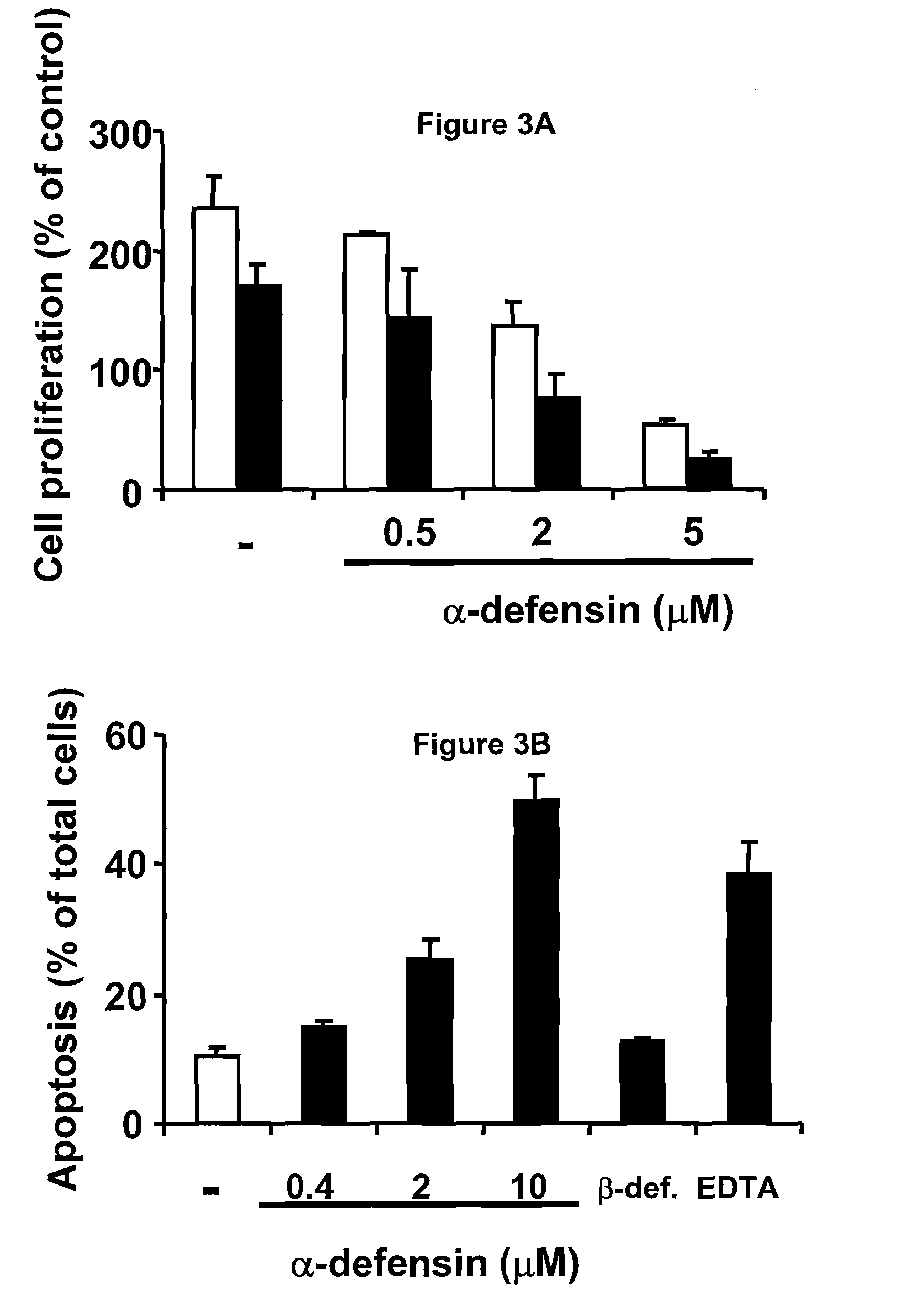Inhibition of Angiogenesis by Neutrophil Alpha-Defensins
an angiogenesis and neutrophil alpha-defensin technology, applied in the direction of angiogenin, peptide/protein ingredients, drug compositions, etc., can solve the problem that the manner in which neutrophils regulate angiogenesis in vivo has not been rigorously investigated, and achieves the effect of inhibiting angiogenesis, reducing the level of angiogenesis, and enhancing interaction
- Summary
- Abstract
- Description
- Claims
- Application Information
AI Technical Summary
Benefits of technology
Problems solved by technology
Method used
Image
Examples
experimental examples
[0160]The invention is further described in detail by reference to the following experimental examples. These examples are provided for purposes of illustration only, and are not intended to be limiting unless otherwise specified. Thus, the invention should in no way be construed as being limited to the following examples, but rather, should be construed to encompass any and all variations which become evident as a result of the teaching provided herein.
Materials and Methods
[0161]Reagents: α-defensins (human neutrophil peptides 1-3) were isolated from human Neutrophils and from sputum of cystic fibrosis patients and characterized as described by Harwig et al. (1994, Methods Enzymol. 236-:160-172). Three bands of HNP1-3 were detected on SDS-PAGE by western blot and commassie staining. A murine monoclonal antibody against human α-defensin was used. Lipoprotein (a) [Lp(a)] was isolated using lysinesepharose chromatography as described by Bdeir et al. (1999, Blood 94:2007-2019). Recombi...
example 1
Inhibition of Endothelial Cell Adhesion and Migration by α-Defensins
[0169]Endothelial cells adhere via different integrins to matrix proteins such as FN, FBG, or VN. Whereas endothelial cell adhesion to FBG and VN is predominantly dependent on αv-integrins, β1-integrins mediate adhesion to FN (FIG. 1A). The effect of α-defensins on the adhesion of HUVEC and BREC to these different matrix proteins was investigated. α-defensins specifically blocked endothelial cell adhesion to FN, whereas adhesion to FBG or VN was not affected (FIG. 1A). The anti-adhesive effect of α-defensins was dose-dependent (FIG. 1B), reaching a maximum of 90% at α-defensin concentration of 10 μM. well within the plasma concentration detected in systemic infection. As α-defensins promote the binding of Lp(a) to FN in the extracellular matrix of vascular cells, the effect of Lp(a) on the antiadhesive activity of α-defensins was tested. Lp(a) did not affect endothelial cell adhesion to any of the substrates directl...
example 2
Inhibition of Endothelial Proliferation by α-Defensins
[0171]Endothelial cell proliferation is stimulated during angiogenesis. Therefore, the influence of α-defensins on HUVEC proliferation was examined by measuring de novo DNA synthesis by measuring the incorporation of BrdU. VEGF and sphingosine-1-phosphate are known activators of endothelial cell proliferation. Both agonists increased DNA synthesis approximately two-fold over a period of 24 hours. HUVEC proliferation was inhibited in the presence of α-defensins in a dose-dependent manner both under control conditions as well as under stimulation with VEGF or sphingosine-1-phosphate (FIG. 3A). To elucidate the mechanism by which α-defensins inhibit proliferation, the induction of apoptosis by α-defensins was examined. α-defensins induced the apoptosis of HUVEC cultivated on FN-coated plates in a dose-dependent manner (FIG. 3B). In contrast, β-defensins did not influence HUVEC proliferation or apoptosis at the same concentrations (F...
PUM
| Property | Measurement | Unit |
|---|---|---|
| concentration | aaaaa | aaaaa |
| concentrations | aaaaa | aaaaa |
| concentrations | aaaaa | aaaaa |
Abstract
Description
Claims
Application Information
 Login to View More
Login to View More - R&D
- Intellectual Property
- Life Sciences
- Materials
- Tech Scout
- Unparalleled Data Quality
- Higher Quality Content
- 60% Fewer Hallucinations
Browse by: Latest US Patents, China's latest patents, Technical Efficacy Thesaurus, Application Domain, Technology Topic, Popular Technical Reports.
© 2025 PatSnap. All rights reserved.Legal|Privacy policy|Modern Slavery Act Transparency Statement|Sitemap|About US| Contact US: help@patsnap.com



